
|
| Illustration: Helina Chin |
Cosmic explorers have built an enormous camera to seek the invisible. Jessica Shugart illuminates their quest. Illustrated by Helina Chin.
Perched atop a rugged peak in the north Chilean Andes, one of the world's largest cameras is taking portraits of deep space. Light traveling for billions of years tickles the camera’s gigantic eye every night, yielding crisp images of ancient clusters of galaxies. But the explorers who built the camera seek imprints of something dark and rather disturbing within the pretty pictures: a pervasive, invisible force pushing the universe apart.
Astronomers first exposed this force 15 years ago amidst an array of exploding stars. They had expected the explosions to tell them how much the expansion of the universe was slowing down. Instead, they came to the shocking conclusion that it was speeding up.
Dark energy — the name given to the obscure driver of cosmic acceleration — is just as enigmatic today. “When you say ‘dark energy,’ what you really mean is something you don’t know about,” says cosmologist David Burke at Stanford's Kavli Institute for Particle Astrophysics and Cosmology (KIPAC).
Is dark energy an enduring force that has always been with us, and will be forevermore? Does it fit neatly into Albert Einstein’s theories of relativity, or will its presence force us to rethink all we know about gravity? What is it?
A global team of astronomers, physicists, engineers and dreamers intends to find out. Through the wide lens of the Dark Energy Camera (DECam), the group will search for subtle changes in the body language of the universe. Within the colors of distant supernovae, the clumpiness of galaxy clusters, and the bending of primordial light lie clues about the origin of our universe and, perhaps, its future.
Come to the dark side
David Burke spent most of his career as a particle physicist immersed in the strange miniature world of quarks, muons and bosons. The mystical questions of dark energy were enough to drive him from a subterranean particle collider to a mountaintop observatory. “Cosmology asks compelling questions,” he says. “How was the universe born? What is its history? Where is it headed?”
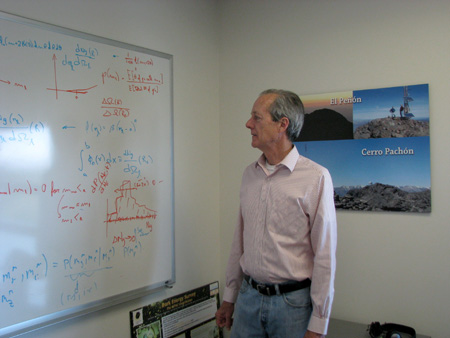
Photo: Jessica Shugart |
Cosmologist David Burke |
|
|
A large picture of the Cerro Tololo Inter-American Observatory in Chile — home of the Dark Energy Camera — now hangs in his office. For what he calls “the last third” of his career, Burke hopes to tap into the most fundamental questions about how the universe works. He is part of a Bay area contingent of scientists playing key roles in the Dark Energy Survey, led by the Fermi National Accelerator Laboratory. The survey’s international players will use DECam to answer the fundamental questions that dark energy poses.
Particle physicist Natalie Roe of Lawrence Berkeley National Laboratory (LBNL), who directed the design of DECam’s detectors, also joined the dark side. “It’s the Copernican principle taken to an extreme,” Roe says. “We’re really just a small part of a small slice of the pie, and I think it’s in the nature of the human spirit to try to understand things that are bigger than we are.”
The parts of the universe we can see — galaxies, stars, planets, us — make up a little less than 5 percent of the whole. The remaining 95 percent consists of dark energy (~68 percent) and dark matter (~27 percent). Dark matter is invisible material that neither reflects nor radiates light, but makes its presence known by its gravitational pull. Our Milky Way galaxy is surrounded by a “dark matter halo” that makes up 95 percent of its mass. Scientists don’t yet know what stuff dark matter is made of, but they do know, at least, that it’s made of stuff.
Dark energy has no such restriction. In 1998, two teams of cosmologists made the Nobel prize–winning observation that distant supernovae were moving away from us at a quickening pace. They concluded that the cosmos was expanding faster than it did in the past. Whatever mysterious force was responsible, it seemed to have a leg up on gravity in a cosmic tug-of-war.
“The universe is trying to expand, but gravity and matter are trying to pull it back together again, so you’re seeing this competition,” says Burke. “It looked like it was slowing down — like the matter was winning — but now we know that’s not true.”
Dark energy could be a constant factor, an inherent quality of space that existed since the Big Bang. Or, it could be a relatively new kid in town: an eerily evolving force field that some call “quintessence,” growing more powerful with time. A third option is that dark energy is a phantom we invented to compensate for our failure to grasp gravity’s true essence.
“Let’s wait and see what nature tells us,” says Roe. “Based on prior experience, it will probably be something out of left field that we never thought of. That’s what makes this kind of science so exciting.”
DECam will look deep into the past to reveal the struggle between dark energy and vast webs of matter that coalesced as our universe evolved. Just as our understanding of biological evolution deepens as we uncover older layers of fossils, an accurate interpretation of cosmic evolution requires us to spy immense numbers of ancient galactic relics.
Blasts from the past
A camera, by definition, captures light. Dark energy, as its name suggests, is completely devoid of it. So DECam must look at the way dark energy affects the objects in the universe that do give off light: stars and galaxies.
Distant supernovae — exploding stars that briefly outshine entire galaxies — will serve as one way to measure cosmic expansion. Astronomers first discovered dark energy using this technique on dozens of supernovae, but DECam will examine 4,000 such explosions.
Certain supernovae glow with a predictable energy, so scientists can estimate how far away they are by measuring their apparent brightness — just as drivers gauge the distance to an oncoming car by how brightly its headlights appear. DECam will look at supernovae up to eight billion light years away, from a time when our universe was less than half its current age. During the light waves’ eight-billion-year journey, the expanding universe stretches their rainbow of colors toward the longest wavelength in the spectrum of light: red. So the old light’s redness upon arrival — its “redshift” — can be used as a carrier pigeon of sorts, bringing with it the story of cosmic expansion.
But these redshift measurements offer no clue about how dark energy affects the "stuff" in the universe. To get at this question, DECam will take stock of 300 million galaxies — the most ever recorded in one project — to compare how many of them existed (and how friendly they were with one another) at different epochs in the universe's history.
We know the universe was smoother in its infancy and became clumpier over time as gravity pulled galaxies into clusters. But dark energy interfered along the way, like a meddlesome chaperone at a junior high dance. By mapping how structures in the universe grew with time, cosmologists will reveal how this repulsive force altered cosmic evolution.
Because invisible dark matter dominates the substance of each galaxy, the DECam team must account for it as well. To measure the amount of dark matter in galactic structures, the team will use a technique called "gravitational lensing." When light from a distant galaxy travels through space and passes near another dark matter–enshrouded galaxy, gravity bends the traveling light before it reaches us. Lensing quantifies this warping and reveals how much total matter (dark + twinkling) lives in the galaxy in the middle.
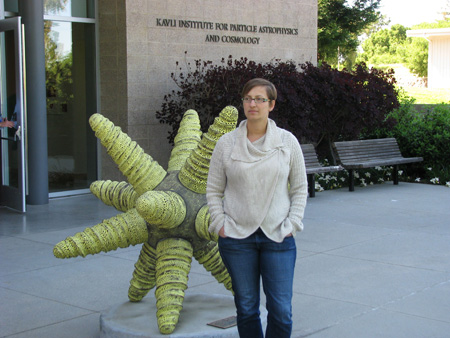
Photo: Jessica Shugart |
Cosmologist Risa Wechsler |
|
|
"It's becoming really clear that if you want to understand these things, you have to solve the whole puzzle," says cosmologist Risa Wechsler of KIPAC. She and her compadres plan to use DECam's wide view to do just that.
Eye on the mountain
The survey team placed its prized camera onto the U.S.-owned Victor Blanco 4-meter telescope in Chile. The massive 1970s-era telescope once held heavy photographic plates in its viewing cage. Astronomers took advantage of this sturdy structure to mount DECam: a four-ton digital behemoth the size of a small car.
After light waves from space enter the telescope, they bounce off of Blanco's mirror, through the lenses of DECam's intricate optical system, and onto an array of silicon detectors. The camera takes 400 shots per night, each covering an area 20 times the size of the full moon. Each image exposes the universe as it was billions of years ago.
DECam's giant lenses make it one of the largest cameras ever built. The complex series of five lenses gives the camera its wide field of view, tracing dark energy on a grander scale than any other telescope. The largest lens weighs 380 pounds and is more than three feet wide.
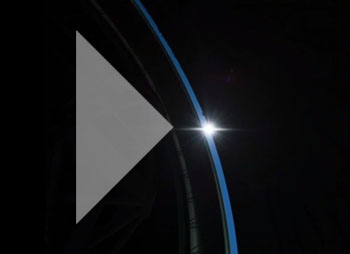 |
Video: In this narrated slideshow, Jessica Shugart describes the Dark Energy Camera (DECam), mounted on a telescope in Chile to seek clues about the nature of an invisible force pushing the universe apart. (Click on image to launch slideshow.) |
|
|
The optics were so daring that no one could project how well they would perform on a real telescope. So the first sharp images, taken in September 2012, thrilled David Burke: "I looked at them, and my first thought was, 'Rebecca got it right.'"
"Rebecca" is Rebecca Bernstein, the UC Santa Cruz cosmologist who designed DECam's ambitious optical system. Herding and taming dim rays of light from the ancient universe is Bernstein's specialty. She lights up as she rummages through files in her computer with names like "Cool," "Very cool," and "Really cool." Inside the files are movies showing the trajectories of light passing through different telescopes she's worked on, each one presenting a unique obstacle course for the light ensnared within its domain.
DECam's lenses prepare light for the camera's flat sheet of detectors, which can only read light rays at one angle: straight on. "Our eye has only one lens, and we still have a wide field of view," Bernstein explains, "but that's because our retina is curved." Her design came to life at University College London, where opticians shaped the glass quintuple to Bernstein's specifications.
Like any camera's detectors, the ones on DECam translate photons of light into electrons — a palatable form for a computer to digest and spit out an image. But DECam's detectors outsize others by astronomical proportions. For example, the camera detector in an iPhone measures one-third of an inch square. DECam's iridescent array of 74 detectors, or "charge-coupled devices" (CCDs), forms a honeycomb shape the size of an extra large pizza. Each CCD contains several million of the camera's 570 million pixels.
"Each one of these pixels is like a bucket," says Chris Bebek, a member of the CCD team at LBNL. "Consider the photons of light like raindrops. They fall into buckets, are retained there, and then buckets get emptied, transporting the raindrops down the line." What emerges is an electronic representation of the amount of light that landed on each pixel: an image of the sky.
Engineers Nicholas Palaio and Stephen Holland have led the CCD lab at Berkeley for more than two decades. Palaio manages the facility — a Class-10 clean room where cartoon-size switches tightly control every aspect of the environment — while Holland designs innovative CCDs, including DECam's.
"Steve has been very modest about this, but he invented the process for making CCDs on this very pure silicon material," says Palaio. "You can't go to Intel and say, 'Build me these detectors.' They just don't work with that kind of material."
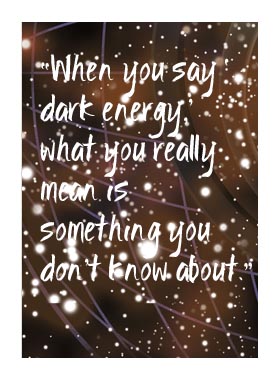 The defining characteristic of DECam's CCDs is their ability to capture the "old light" stretched into longer, redder wavelengths by the expansion of the universe. Normal CCDs are too thin to capture red light effectively, so Holland designed DECam's CCDs to be ten times thicker. And unlike the silicon wafers used in semiconductors, the business end of a light-sensing CCD is what Palaio calls its "pristine backside." Incoming light hits a pitch-black smooth coating on this backside, preventing even a smidgeon of it from scattering. Every ray of eight-billion-year-old light is too precious to waste. The defining characteristic of DECam's CCDs is their ability to capture the "old light" stretched into longer, redder wavelengths by the expansion of the universe. Normal CCDs are too thin to capture red light effectively, so Holland designed DECam's CCDs to be ten times thicker. And unlike the silicon wafers used in semiconductors, the business end of a light-sensing CCD is what Palaio calls its "pristine backside." Incoming light hits a pitch-black smooth coating on this backside, preventing even a smidgeon of it from scattering. Every ray of eight-billion-year-old light is too precious to waste.
DECam stares into space from a lofty position on an Andean mountaintop, but missions to explore dark energy from space also glimmer in the future. Photos taken from space come back crisper than those captured from under the haze of Earth's atmosphere. But space-based missions are costly, and they are far riskier than ground-based projects.
"They both have their advantages," says Neil Gehrels, lead project scientist for NASA's proposed dark energy mission, the Wide Field Infrared Space Telescope (WFIRST). The mission is biding its time until NASA's budget can accommodate its price tag of $1 billion to $2 billion. A rival European satellite, called Euclid, is slated for launch in 2018. But DECam's $50 million cost was low enough to prevent such delays.
"It's important to have multiple observatories," Gehrels says. "That's the only way we're going to make progress on understanding why the universe is accelerating the way it is."
Dark data overload
During its five-year stint as the survey's workhorse, DECam will capture 400 one-gigabyte images — the equivalent of 100,000 songs — every night. These massive files will zip via optical link to the National Center for Supercomputing Applications in Illinois. "This huge crunching code then goes through and finds all the bright objects," David Burke says. "It can tell you whether it thinks something is a galaxy or a star."
The end result? A database with 300 million galactic entries.
Risa Wechsler of KIPAC has spent the last decade preparing for this deluge. She creates supercomputer simulations of the universe to help the team comprehend the real data when it arrives. In these simulations, Wechsler calls the shots. "I can construct a universe where we know what dark matter is, and we know what dark energy is, and we know how galaxies are connected," she says.
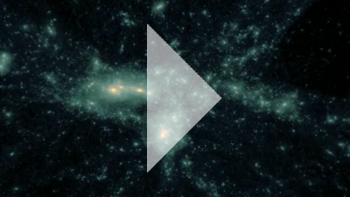
|
A simulation by Risa Wechsler traces the formation of a massive cluster of galaxies over 13 billion years. |
|
|
Wechsler and her colleagues also create stunning 3D visualizations of the different worlds they invent with each simulation. In these intergalactic sagas spanning billions of years, dark matter filaments protrude like invasive vines, galactic structures heave and contract, and webs of matter coalesce. Ironically, these psychedelic movies will help cosmologists get a better grasp on the reality of their data.
DECam's deep snapshots may reveal whether dark energy is a constant quality of space or a spooky field of some kind — or whether our view of gravity needs a reality check. But what happens when dark energy becomes a known quantity? Perhaps the questions the Dark Energy Survey will ignite are more alluring than the answers it will find.
What, if anything, lies beyond our expanding universe? Some theorists propose that ours is but one universe among millions of others floating like bubbles in a "multiverse" sea. Some of these universes may contain so much repulsive dark energy that stars and galaxies failed to form. Others might have been born with so little that gravity doomed them to collapse. But the amount of dark energy in our universe allowed stars, galaxies, and planets to form. If the multiverse is real, wouldn't our universe's dark energy number be just as arbitrary as the just-right distance between Earth and the sun?

Photo: Jessica Shugart |
Cosmologist Aaron Roodman |
|
|
"I suppose [the multiverse] is possible, but you need better evidence to convince me of it than the fact that you can't explain one number," says KIPAC's Aaron Roodman, yet another particle physicist coaxed into cosmology by the sweet nothings of dark energy. "You can never prove it; you can never shed any light on it. It says there's no deeper understanding possible."
Roodman, who programmed the system that refocuses DECam hundreds of times each night, finds enough intrigue in the measurable quantities of our own cosmos. He and other survey members are involved in an even more ambitious project, the 8.4-meter Large Synoptic Survey Telescope, which should start canvassing the sky from a neighboring mountaintop in Chile by the end of the decade.
Although scientists on the Dark Energy Survey study the most invisible entities in the universe, they thrive on making connections between the dark and the light. "The exciting part to me," says Wechsler, "is how much we can see."
Story ©2013 by Jessica Shugart. For reproduction requests, contact the Science Communication Program office.
Top
Biographies
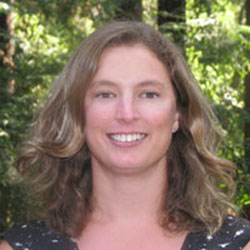 Jessica Shugart Jessica Shugart
B.S. (molecular and cell biology) University of California, San Diego
Ph.D. (immunology) University of California, Berkeley
Internship: Science News (Washington, D.C.)
I got into scientific research to unravel the never-ending complexity behind seemingly simple things. Through the lens of science, boring colorless liquids teem with DNA molecules, and lonesome stars twinkling in the distance harbor families of planets. As an immunologist, I strained to see the molecular signals that turn T cells into murderers of microbes.
Yet as each tiny new piece of data came in, I realized that the part of science I loved the most was the telling of it. A plain old bar graph combined with just the right vivid metaphor could illuminate a whole new world—not just for my readers, but also for me. As a science writer, I hope to pull back the veil of jargon that too often separates us from the most human of endeavors.
Jessica Shugart web site
. . . . . . . . . . . . . . . . . . . . . . . . . . . . . . . . . . . . . . . . . . . . . . . . . . .
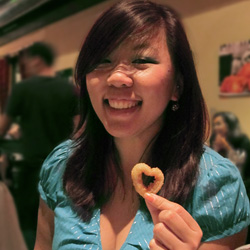
Helena Chin
B.S. (plant biology) University of California, Davis Adobe
Internship: Smithsonian Institution National Museum of Natural History , Department of Botany (Washington, D.C.)
From drawing images out of her science books in second grade all the way to covering her walls in plant structures, molecules and diagrams in college, Helina has always been riding the line between art and science. After graduating from UC Davis, she worked in wine country and took graphic design courses at Santa Rosa Junior College.
Helina is inspired by colorful and unusual scientific phenomena and hopes to continue producing imagery that evokes an emotional response and get people to care about the world around us.
Helena Chin web site
Top |

